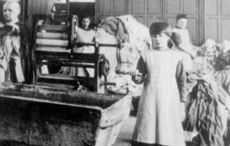A Notre Dame Professor is leading a team of research students in a quest to unearth the historical links between the Donegal Island of Arranmore and Beaver Island in Michigan.
If you really want to understand Irish America you should look at Beaver Island according to Archaeology Professor, Deb Rotman. She first learnt about the significance of the island four years ago and she carried out her first dig there this past summer.
Beaver Island which is situated about 30 miles off the Michigan coast was twinned with Arranmore Island, off the coast of Donegal, in 2000.
Arranmore is home to a beaver monument, which represents the link between he two.
During the 19th century, several Donegal emigrants made Beaver Island their home, transforming it into a stateside Donegal Gaeltacht at the turn of the 20th century.
According to the Arranmore Ferry Company, Charlie O’Donnell and his family were the first emigrants to travel to Beaver Island after they were evicted from their home in 1851. Several families followed and by 1880, estimates suggest there were more than 250 families with connections to the Donegal Island.
After conducting research on Beaver Island, the Note Dame professor decided to travel to Donegal to investigate the links.
"When I was there in May it was very quiet, but it was just starkly beautiful," she told the Donegal Democrat.
Initially the archeology professor imagined that the Donegal island would have similar aesthetics to Beaver Island, so that for the emigrants it "would be like being home".
The professor believes that the emigrants were drawn to the island by the remoteness. Also, the coastline of Beaver Island provides excellent fishing, which would have been a draw for the Irish newcomers.
The archaeological dig on Beaver Island during the summer unearthed several items such as glassware, toys, and buckles.
"We're finding everything you would expect in terms of the kind of household items that people would use," Deb said.
"We're still processing the artifacts," she added.
The items the dig uncovered are clearly stratified, which means "as you dig deeper into the ground, the further back in time you go," Deb said.
Some Notre Dame students are planning a trip to the island next month, to continue their research. They will interact with locals and older residents in a bid to learn more about the history of the island. They also plan to examine derelict cottages on the island and conduct research in the National Archives and National Library in Dublin.
Deb, who heads the undergraduate archaeology study program at Notre Dame, said that while many of her students are Irish-American, the project has also drawn students from a diverse range of backgrounds.
"If there is a story they want to tell, if they want to contribute in some way to the project in terms of their knowledge and history, we would love for them to be involved. We would like this to be a community endeavour, both Beaver Island and Árainn Mór." Deb said.
The Beaver Island Historical Society is an official partner of the Notre Dame project.
"There are so many interesting variables and chapters in this story that really anyone could find something that piques their interest," she said.




Comments